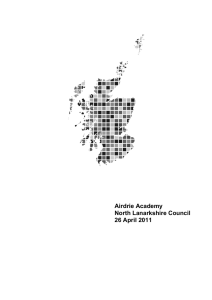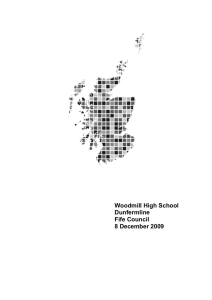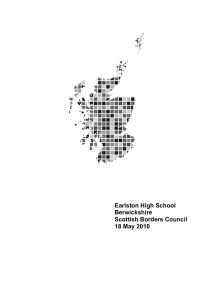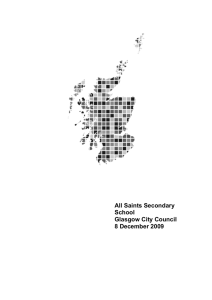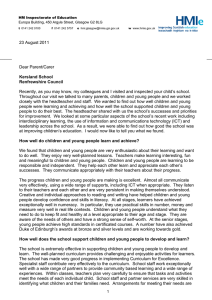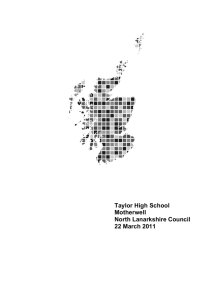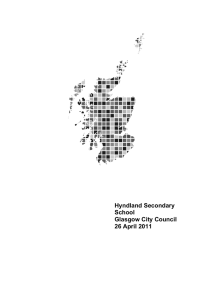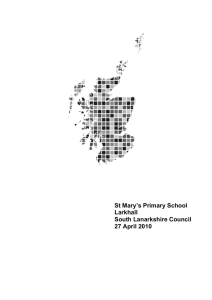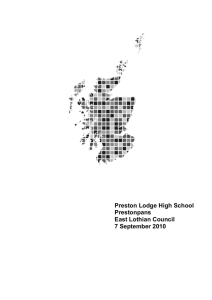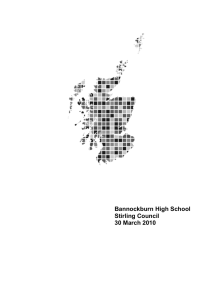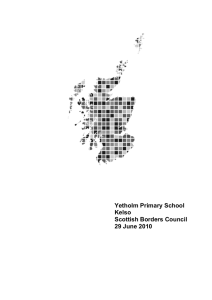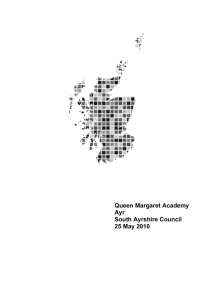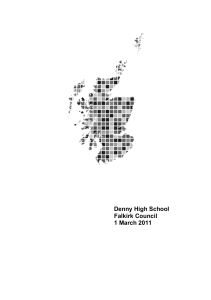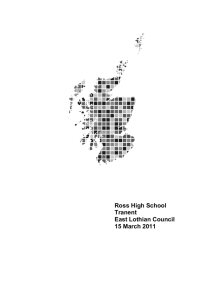James Gillespie’s High School The City of Edinburgh
advertisement
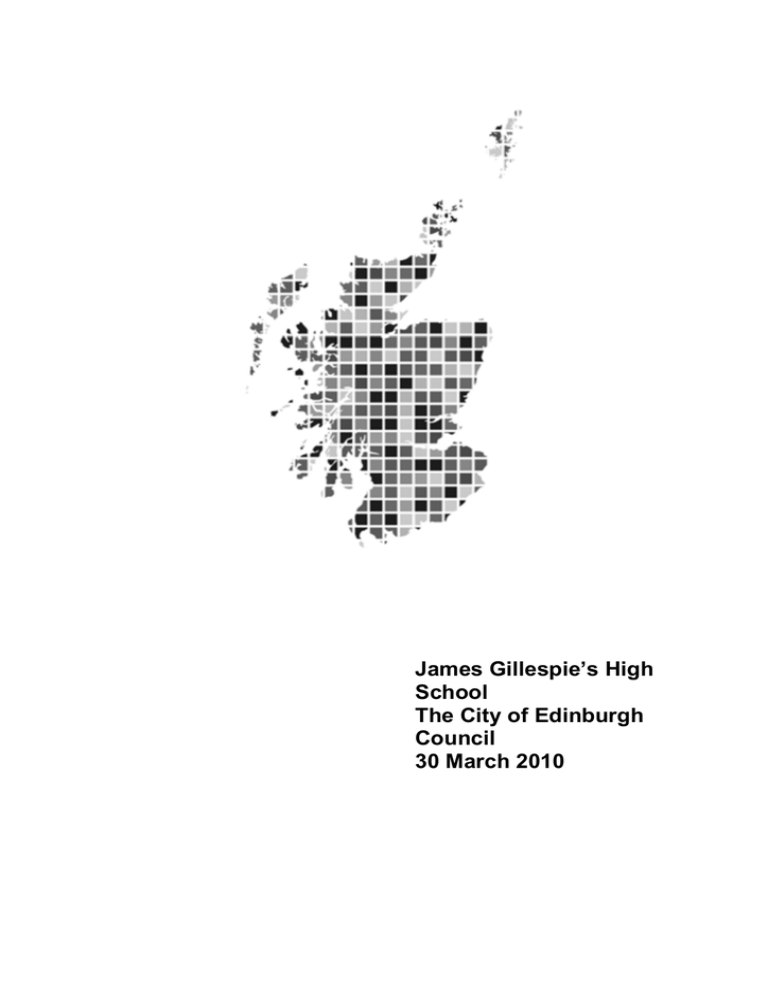
James Gillespie’s High School The City of Edinburgh Council 30 March 2010 HM Inspectorate of Education (HMIE) inspects schools in order to let parents1, young people and the local community know whether their school provides a good education. Inspectors also discuss with school staff how they can improve the quality of education. At the beginning of the inspection, we ask the headteacher and staff about the strengths of the school, what needs to improve, and how they know. We use the information they give us to help us plan what we are going to look at. During the inspection, we go into classes and join other activities which young people are involved in. We also gather the views of young people, parents, staff and members of the local community. We find their views very helpful and use them together with the other information we have collected to arrive at our view of the quality of education. This report tells you what we found during the inspection and the quality of education in the school. We describe how well young people are doing, how good the school is at helping them to learn and how well it cares for them. We comment on how well staff, parents and young people work together and how they go about improving the school. We also comment on how well the school works with other groups in the community, including services which support young people. Finally, we focus on how well the school is led and how staff help the school achieve its aims. If you would like to learn more about our inspection of the school, please visit www.hmie.gov.uk. Here you can find analyses of questionnaire returns from young people, parents and staff, and details about young people’s examination performance. We will not provide questionnaire analyses where the numbers of returns are so small that they could identify individuals. Where applicable there will also be a report on the learning community surrounding the school. 1 Throughout this report, the term ‘parents’ should be taken to include foster carers, residential care staff and carers who are relatives or friends. Contents 1. The school 2. Particular strengths of the school 3. How well do young people learn and achieve? 4. How well do staff work with others to support young people’s learning? 5. Are staff and young people actively involved in improving their school community? 6. Does the school have high expectations of all young people? 7. Does the school have a clear sense of direction? 8. What happens next? 1. The school James Gillespie’s High School is a non-denominational school which serves the south of the City of Edinburgh. The roll was 1130 when the inspection was carried out in February 2010. Young people’s attendance was in line with the national average in 2008/09. S5/S6 were on prelim study leave during the inspection. Plans are underway to build a new school on the existing site, with a decant scheduled to begin in 2012. 1 2. Particular strengths of the school • The active contribution of all staff to the life of the school and their positive relationships with young people. • Courteous, articulate and confident young people who are very proud of their school. • The impressive range of activities for young people to broaden their experiences and achieve widely especially in music, sports and international education. • The attainment of many young people in national examinations. • The committed leadership of the headteacher in promoting a vibrant culture. 3. How well do young people learn and achieve? Learning and achievement Young people enjoy learning at school and want to do well. Almost all feel that the school helps them to become more confident. They work very well together and are encouraged to be independent learners. Well-planned activities such as field trips and talks from outside speakers widen learners’ experiences. In a number of subjects, teachers successfully encourage young people to reflect on and discuss their learning. This good practice should be developed further to help young people be clearer about their strengths as learners and how they can improve their work. An increasing number of departments are making very effective use of information and communications technology (ICT) such as Smartboards and blogs to help young people be responsible for their own learning. Across all stages, many young people enjoy success through taking part in an impressive range of activities including sports, music, 2 debating, enterprise and drama. Some young people perform at national level in sports and have won prestigious events such as the Pushkin writing prize, the Donald Dewar Memorial Debating prize and the ALBA Gaelic film competition. Young people at all stages show a mature understanding of social issues and global citizenship. By S6, they demonstrate their social responsibility through the impressive work of the Amnesty International group, the Youth Philanthropy Initiative and the Saffron Café. Groups of young people at S6 travel annually to Durban with their teachers as part of an established South African project. This develops their sense of social responsibility and represents a culmination of work that builds from S1. By the end of S2, most young people achieve or exceed appropriate national levels of attainment in reading, writing and mathematics. The school is gathering better information to monitor young people’s progress in other areas of the curriculum. At S4 to S6, results in national examinations have been consistently above or well above national averages. The proportion of young people gaining awards is poorer than those schools which serve young people with similar needs and backgrounds. Staff are using a range of effective approaches to improve the attainment of specific groups of young people. On leaving school, a consistently high proportion of young people move into higher education. Curriculum and meeting learning needs The school places high priority on providing an enriching curriculum. Staff review the curriculum annually to improve provision and have begun to develop the curriculum to better meet the needs of all learners. For example, young people can study three sciences or two social subjects or attend college twice per week. The curriculum promotes young people’s practical understanding of sustainability, emotional health, international education and active citizenship extremely well. The school provides two hours of high-quality physical education each week in S1 to S3 but not in S4 to S6. Religious and moral education is offered at S1 to S4 only. Staff are fully engaged in rising to the challenges of Curriculum for Excellence. Well-planned 3 improvements have been made to the programmes for literacy and numeracy. The school has strong curriculum links with primary schools in subjects such as science and mathematics. It should build on these strengths to provide greater continuity for children entering from Tollcross Primary School who learn through Gaelic-medium education. Staff work successfully to provide the most vulnerable young people with a personalised curriculum. The school’s programme for personal and social education has recently been reviewed and covers a wide range of appropriate topics. Teachers plan tasks and activities that meet the needs of most learners. In the most effective lessons, these activities relate well to real-life contexts and offer suitable levels of challenge to all young people. At times, lessons do not always meet the diverse range of needs in class and the pace of learning is too slow. Teachers are vigilant in alerting pastoral and support for learning staff to any concerns about a young person. The school’s counselling service is highly valued by young people. Support for learning staff effectively identify young people who need additional support and provide helpful assistance in the support base. Some young people with English as an additional language are making very good progress. Others require more intensive support than the school is currently able to provide. Vulnerable young people are very well supported by learning assistants and through an innovative ‘befrienders’ scheme. Staff now need to develop clear targets in support plans for the few young people with more complex support needs. These should be shared with teachers and parents in order to optimise the chances for all young people to make appropriate progress. Most teachers use a good variety of learning and teaching approaches and respond sensitively if a young person is having difficulties with any aspect of their learning. Young people benefit from the innovative and creative teaching in some departments across the school. 4. How well do staff work with others to support young people’s learning? The school works closely with its active Parent Council and has a 4 well-deserved reputation in the local community for valuing ethnic diversity. The Council, in partnership with the school, recently consulted with parents on health promotion which contributed to a Healthy Schools Award Stage 2 from the council. Almost all parents are happy with the school and attend parents’ evenings. Many are actively involved in supporting school events and fundraising. However, a significant minority feel that the school does not ask for or take account of their views. Some want better communication and more regular information on their child’s progress. The school should listen carefully to the concerns being raised by parents and communicate actions taken in response to these. The pastoral support team are beginning to work closely with Skills Development Scotland to help raise the aspirations of those young people at risk of becoming disengaged. Some senior young people and their parents would like earlier information about university and career options. Complaints to the school are handled well. 5. Are staff and young people actively involved in improving their school community? Most young people are actively involved in committees and feel they have a voice. The student council is energetic and uses its budget very well to make improvements. Those in senior classes raise large sums of money for charities through planning whole-school events such as Diversecity. The headteacher has successfully created an atmosphere where change is achieved through collective and collaborative activity. The contribution of staff to the life of the school is outstanding and all give very generously of their time to support young people. Staff morale is high. Most show a strong commitment to self-evaluation and there are some examples of very effective practice in individual departments. Senior staff have recently introduced ‘learning conversations’ with classes which also release teachers to benefit from visits to other classes. They should build on this good work to develop a more rigorous approach to analysing data and working across departments, and proactively with partners, to share information and pool resources. The school’s plans to introduce portfolios of young people’s experience and an ICT-based system for 5 monitoring and tracking young people’s progress and achievement will help to bring even greater benefits to all young people. 6. Does the school have high expectations of all young people? The school has a very positive ethos and staff and young people are extremely proud of their school. Young people are courteous, articulate and confident. They are encouraged to live healthy lives. However, the quality of facilities and accommodation is poor, especially the toilets and changing rooms. Young people have a strong sense of equality and fairness which is demonstrated in their varied approaches to active citizenship. Staff are fully aware of their responsibilities to protect young people. They deal well with any instances of bullying and have high expectations of attainment and achievement. Most staff have high expectations of young people’s behaviour but low level disruption interrupts learning in a few classes. The school celebrates achievements in a variety of ways such as the informative website, achievement assemblies and the Sporting Hall of Fame. The school does not fully meet the arrangements for religious observance. 7. Does the school have a clear sense of direction? The school has a shared set of vision, values and aims which help to provide clear direction. The headteacher models a thoughtful and consultative approach to leadership. His senior team is fully committed to improving the lives of young people. Staff at all levels are actively involved in effective working groups and willingly embrace change. Support staff ensure the smooth day-to-day running of the school and provide valued support to young people. Principal teachers in a number of departments are ably leading developments which promote high attainment. 8. What happens next? We are confident that the school will be able to make the necessary improvements in light of the inspection findings. As a result, we will 6 make no more visits in connection with this inspection. The school and the education authority will inform parents about the school’s progress in improving the quality of education. We have agreed the following areas for improvement with the school and education authority. • Continue to improve self-evaluation in order to track more closely the progress and achievement of all young people. • Develop more systematic approaches to gathering and responding to the views of parents and young people. • Continue to share information and learning and teaching approaches in order to meet the needs of all young people. • Review arrangements for religious observance. Quality indicators help schools, education authorities and inspectors to judge what is good and what needs to be improved in the work of the school. You can find these quality indicators in the HMIE publication How good is our school?. Following the inspection of each school, the Scottish Government gathers evaluations of three important quality indicators to keep track of how well all Scottish schools are doing. Here are the evaluations for James Gillespie’s High School. Improvements in performance Learners’ experiences Meeting learning needs very good very good good We also evaluated the following aspects of the work of the school. The curriculum Improvement through self-evaluation HM Inspector: Fiona Carlisle very good good 30 March 2010 7 When we write reports, we use the following word scale so that our readers can see clearly what our judgments mean. excellent very good good means means means satisfactory weak unsatisfactory means means means outstanding, sector leading major strengths important strengths with some areas for improvement strengths just outweigh weaknesses important weaknesses major weaknesses If you would like to find out more about our inspections or get an electronic copy of this report, please go to www.hmie.gov.uk. Please contact us if you want to know how to get the report in a different format, for example, in a translation, or if you wish to comment about any aspect of our inspections. You can contact us at HMIEenquiries@hmie.gsi.gov.uk or write to us at BMCT, HM Inspectorate of Education, Denholm House, Almondvale Business Park, Almondvale Way, Livingston EH54 6GA. Text phone users can contact us on 01506 600 236. This is a service for deaf users. Please do not use this number for voice calls as the line will not connect you to a member of staff. You can find our complaints procedure on our website www.hmie.gov.uk or alternatively you can contact our Complaints Manager, at the address above or by telephoning 01506 600259. Crown Copyright 2010 HM Inspectorate of Education
